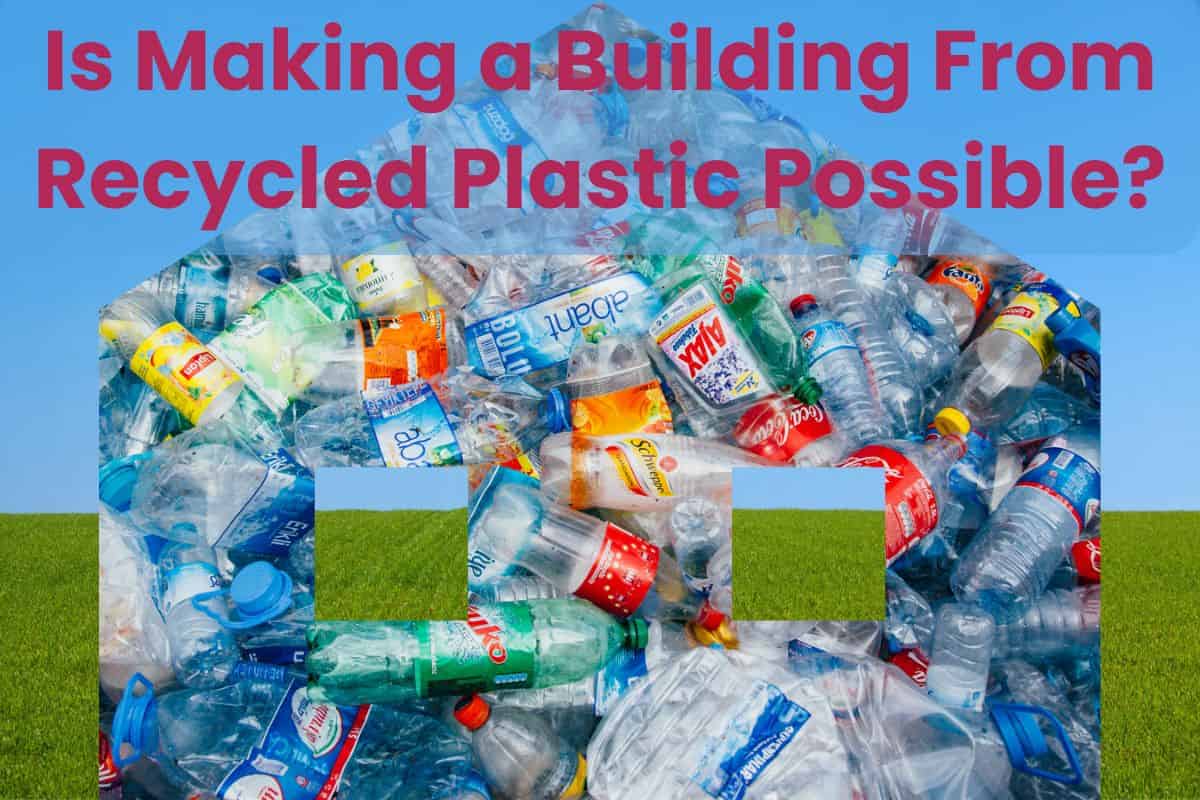Is Making a Building From Recycled Plastic Possible?

Of the more than 9 billion tons of plastic manufactured since the 1950s, only 9% has been recycled, while the rest accumulates in oceans, soils, and landfills.
While recycling plastic waste has been touted as a solution to this menace, building houses from recycled plastic may seem far-fetched. So, is making a building from recycled plastic possible?
Making a building from recycled plastic is possible because plastic is recyclable, strong, waterproof, durable, lightweight, and easy to mold. These are the essential properties builders look for before building with any material. Moreover, recycled plastic fosters eco-building practices.
In the rest of this article, I’ll discuss why recycled plastic is an ideal building material. I’ll also share some examples of buildings built with recycled plastics.
Let’s get started!
Reasons Recycled Plastic Is an Ideal Building Material

The characteristics of a material that make it eligible for use in the construction industry include strength, durability, and other factors such as thermal insulation properties.
The type of building material you choose affects the structure’s stability, durability, and safety for human occupation. You must ensure the material meets these conditions to build a house that meets the International Building Code (IBC) standards.
Recycled plastic is an ideal building material for the following reasons:
- Durability: Recycled plastic is highly resistant and impervious to mold and rot. This quality makes it ideal for building structures expected to last longer.
- Weatherproofing: Plastic is highly resistant to rain and snow. Consequently, it’s suitable for outdoor structures in constant contact with these elements. This means you don’t have to worry about your structural insulated panels made from recycled plastics corroding or rotting due to excessive moisture.
- Lightweight: Unlike many conventional building materials, recycled plastic is lightweight and easy to transport and install. The lightweight material is easy to work with, especially when roofing, because it makes lifting the materials into place much easier.
- Sustainability: The construction industry contributes greatly towards climate change and the depletion of natural resources like trees. As a result, it’s important to use sustainable building materials. Recycled plastic is one such material as it uses less energy, keeps these materials cycling in the economy, and closes the loop on plastic waste management.
- Cost-effectiveness: Building with recycled plastics is often more affordable than using traditional building materials like wood and steel. This makes it an excellent option for budget-conscious builders.
- Strength: The tensile strength of recycled plastic ranges between 4,000 and 21,000 pounds per square inch. With such a high tensile strength, recycled plastic is strong enough to support building structures and withstand extreme weather conditions.
- Excellent insulation: Plastics are great insulators because they don’t have the free electrons to conduct heat like metals. Thus, buildings made with recycled plastic are well-insulated; they keep indoor temperatures comfortable in all seasons. In the process, such buildings help reduce energy costs for heating and cooling.
- Low maintenance: Recycled plastic, unlike concrete, doesn’t crack or splinter. Therefore, it’s easy to maintain and clean. In the process, you save time, money, and energy.
- Versatility: Recycled plastic is easy to work with and can be molded into different shapes. This makes it a suitable material for building structures that need complex and intricate designs.
Examples of Buildings Made From Recycled Plastics
EcoARK Pavilion

EcoARK Pavilion was built in 2010 in Taiwan for use as an exhibition hall during the Taipei International Flora Expo.
The pavilion was built with 1.5 million recycled Polyethylene Terephthalate (PET) bottles. The bottles were melted down into PET pellets. The pellets were then re-engineered into blow-molded bottle-like polli-bricks with interlocking grooves.
The blocks were assembled into rectangular panels to build the 130-meter (427-foot) long pavilion. The panels were coated with fire and water-resistant film to keep them secure.
Although this building is lighter than its traditional counterparts, it’s strong enough to withstand earthquakes and typhoons. It can also resist winds up to 130 km/h (81 mph).
Overall, EcoARK Pavilion’s design showcases a unique use of recycled plastics in construction. It proves that this material can be successfully used for complex structures.
Sandford Home

This is a 1,400-square feet (130-square-meter) house built by the JD Composites company in Sandford, Ontario.
The Sandford Home is a forever home that can last for generations without needing repairs or replacement.
The company used its product—structural insulated panels made from recycled plastic to construct the walls and roof of the home.
The company used over 630,000 recycled plastic bottles to make the 12-foot (3.7-meter) wall and roof. The bottles were melted down into a slurry and shaped into the panels used for the construction.
The Sandford Home is energy-efficient, exceptionally strong, and requires minimal maintenance over its lifespan.
The Plastic Bottle Village

The Plastic Bottle Village is a community of houses in Panama made entirely from recycled plastic bottles.
Robert Bezeau is the pioneer behind this project. He collected over one million plastic bottles for use in the construction project.
Among the structures built by Bezeau are a castle and a dungeon. He intended to use these structures to host visitors on vacation and teach them about up-cycling, recycling, and other initiatives to ‘repent’ for their plastic pollution crimes.
Robert’s creation showcases home insulation, rapid temporary shelters, barns, swimming pools, and animal buildings on the farm as structures that can be built with recycled plastics.
The eco-friendly village was built mainly from recycled PET bottles. The village boasts an educational center, eco-homes, a museum, and a retreat destination.
Plastic Bottle Homes in Nigeria
Plastic bottles are a common construction material in Kaduna village, Nigeria. People in this village rely on the bottle brick technology as an easy and cheaper way to build environmentally friendly houses.
The building process is simple and involves filling PET bottles with sand, then using a soil-cement mix to secure the bottles into structures. The buildings are often plastered and decorated with vibrant colors for aesthetic purposes.
Besides homes, the locals in Kaduna use this technology to build schools, churches, mosques, and community centers.
Final Thoughts On Building From Recycled Plastic
The possibility of making a building from recycled plastic is a tangible reality.
With advancements in technology and innovative approaches to building, it’s now possible to use recycled plastic as a sustainable alternative to traditional building materials.
By building with recycled plastics, we reduce the environmental impact of construction while contributing to the circular economy by keeping plastic waste out of landfills, the oceans and the rest of our environment.
If you’ve read this far, you’re probably an environmentally-conscious person, so you might be interested in reading about these other eco-friendly materials you can use in your construction projects.







